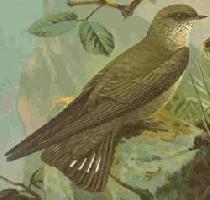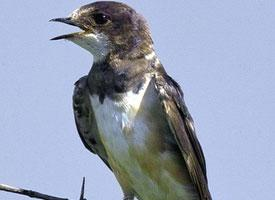
Description de l'animal
The Eurasian crag martin (Ptyonoprogne rupestris), a member of the swallow family (Hirundinidae), is a small, adept flyer renowned for its distinctive aerial maneuvers and preference for rocky habitats. This bird exhibits a blend of subtle yet charming features that contribute to its unique appearance and behavior, making it an interesting subject of study and observation in the avian world.Physically, the Eurasian crag martin is compact and robust, with a body length typically ranging from 13 to 15 cm. It possesses a broad, square tail that is slightly forked, with white patches on the inner web of the tail feathers that are conspicuous during flight. The wings are long and pointed, designed for efficient and agile flying, enabling the bird to execute tight turns and swift chases after airborne insects, which constitute its primary diet.
The plumage of the Eurasian crag martin is predominantly a dusky brown, with a slightly paler underbelly that aids in camouflage against the rocky cliffs and outcrops it favors for nesting. Its throat is noticeably lighter, often a shade of whitish or pale gray, which can be a key identifying feature. The bird's bill is short and black, suitable for catching insects mid-flight, while its legs and feet are also black, small, and adapted to clinging onto vertical surfaces.
One of the most fascinating aspects of the Eurasian crag martin's behavior is its nesting habits. Unlike many of its relatives that may nest in trees or on buildings, this species shows a strong preference for natural cliff faces and occasionally man-made structures such as bridges and dams that mimic these conditions. Nests are constructed with mud and are typically cup-shaped, built on ledges or in crevices where protection from predators and the elements is maximized. The female lays 2 to 5 eggs, which are incubated by both parents, demonstrating a high degree of parental investment in the survival of their offspring.
The Eurasian crag martin is widely distributed across Europe, Asia, and North Africa, displaying some migratory behavior. Birds breeding in the northern parts of their range tend to migrate southwards during the winter months to find more favorable conditions, while populations in warmer regions may be resident year-round. Despite facing threats from habitat destruction and climate change, the species is currently considered of least concern by the International Union for Conservation of Nature (IUCN), thanks to its broad range and relatively stable population numbers.
In conclusion, the Eurasian crag martin is a remarkable bird, not only for its adept flying and distinctive appearance but also for its intriguing nesting habits and adaptability to various environments. Its presence enriches the biodiversity of the rocky habitats it prefers, and it plays a vital role in the ecosystem as a consumer of flying insects. Observing these agile birds in their natural setting offers a fascinating glimpse into the complexity and beauty of avian life.
Animaux similaires
Nouvelles photos d'animaux
Top 10 des animaux
- Dolphin gull (Leucophaeus scoresbii)
- Diana monkey (Cercopithecus diana)
- Moustached guenon (Cercopithecus cephus)
- Galápagos tortoise (Geochelone nigra complex)
- Russian tortoise (Testudo horsfieldii)
- Japanese macaque (Macaca fuscata)
- Stone loach (Barbatula barbatula)
- Greek tortoise (Testudo graeca)
- Common flying dragon (Draco volans)
- Colossal squid (Mesonychoteuthis hamiltoni)


